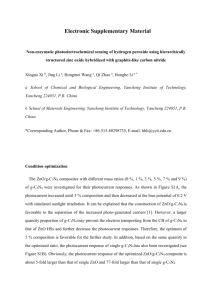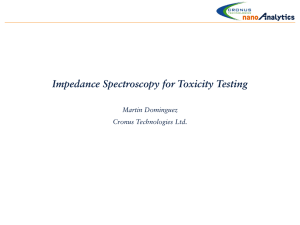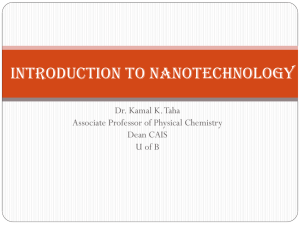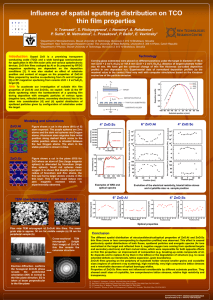1401688
advertisement
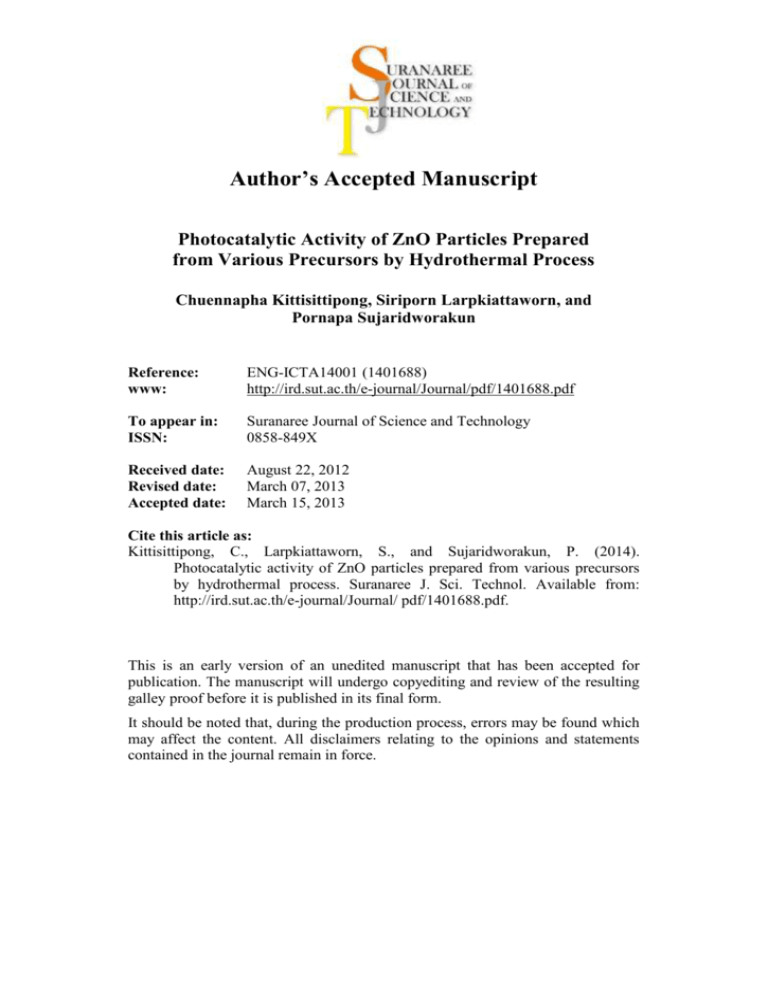
Author’s Accepted Manuscript Photocatalytic Activity of ZnO Particles Prepared from Various Precursors by Hydrothermal Process Chuennapha Kittisittipong, Siriporn Larpkiattaworn, and Pornapa Sujaridworakun Reference: www: ENG-ICTA14001 (1401688) http://ird.sut.ac.th/e-journal/Journal/pdf/1401688.pdf To appear in: ISSN: Suranaree Journal of Science and Technology 0858-849X Received date: Revised date: Accepted date: August 22, 2012 March 07, 2013 March 15, 2013 Cite this article as: Kittisittipong, C., Larpkiattaworn, S., and Sujaridworakun, P. (2014). Photocatalytic activity of ZnO particles prepared from various precursors by hydrothermal process. Suranaree J. Sci. Technol. Available from: http://ird.sut.ac.th/e-journal/Journal/ pdf/1401688.pdf. This is an early version of an unedited manuscript that has been accepted for publication. The manuscript will undergo copyediting and review of the resulting galley proof before it is published in its final form. It should be noted that, during the production process, errors may be found which may affect the content. All disclaimers relating to the opinions and statements contained in the journal remain in force. ACCEPTED MANUSCRIPT PHOTOCATALYTIC ACTIVITY OF ZnO PARTICLES PREPARED FROM VARIOUS PRECURSORS BY HYDROTHERMAL PROCESS Chuennapha Kittisittipong1, Siriporn Larpkiattaworn3, and Pornapa Sujaridworakun1,2* Received: August 22, 2012; Revised: March 07, 2013; Accepted: March 15, 2013 Abstract In this work, ZnO particles with different morphologies and surface areas have been prepared by hydrothermal process using various zinc precursors. The obtained ZnO powders were characterized for phase, morphology, and surface area by X-ray powder diffraction (XRD), Scanning Electron Microscopy (SEM), and Brunauer-Emmet-Teller (BET), respectively. The effect of the zinc precursors on the photocatalytic activity of the resultant ZnO was evaluated through a study of the decomposition of the methylene blue solution under UV-lamp irradiation. It was found that the pure ZnO in the zincite structure was obtained from all precursors which were precipitated by NaOH or KOH under hydrothermal reaction at 150oC for 6h. The results show that the type of precursors had played a significant role on the morphology and surface area of the obtained ZnO which had affected its photocatalytic activity. From the results, the rod-like ZnO particles prepared from zinc nitrate and precipitated by NaOH showed the highest photocatalytic activity compared with the other precursors. Keywords: Photocatalytic activity, ZnO, zinc Precursors, Hydrothermal process Introduction Zinc oxide (ZnO) has many excellent properties in chemical, electrical, and optical fields and in photocatalysis. It has a wide gap semiconductor of about 3.37 eV in the UV region that makes it an efficient UV absorber in the photocatalysis process (Yu et al., 2005; Anzlovar et al., 2008). The morphology and size of the ZnO particles play an important role in these properties that can be 1 Research Unit of Advanced Ceramics, Department of Materials Science, Faculty of Science, Chulalongkorn University, Bangkok, 10330, Thailand. 2 Center of Excellence on Petrochemical and Materials Technology, Chulalongkorn University, Bangkok, 10330, Thailand. E-mail address: pornapa.s@chula.ac.th 3 Thailand Institute of Scientific and Technological Research (TISTR), Klong Luang, Pathum Thani, 12120, Thailand. * Corresponding Author Suranaree J. Sci. Technol.: ENG-ICTA14001 1 ACCEPTED MANUSCRIPT changed completely or modified in dependence on the synthesis route under different preparation conditions (Music et al., 2005; Ristic et al., 2005). ZnO particles can be synthesized via different synthesis methods such as the sol-gel (Van der Rul et al., 2006), microwave (Komarneni et al., 2000), spray pyrolysis (Liu et al., 1986), thermal decomposition (Andres-Verges and Martinez-Gallego, 1992), precipitation (Costa and Baptista, 1993; Haile et al., 1989; Trindade et al., 1994), solvothermal (Inoue et al., 1992), hydrothermal (Lu and Yeh, 2000; Liu et al., 2006), and so on. Among synthesis methods, the hydrothermal method is relatively simple and environmentally friendly. Furthermore it has advantages of obtaining high-crystallized powders with narrow grain size-distribution and high purity without heat treatment at high temperature (Chittofrati and Matijevic, 1990; Nishizawa et al., 1984). The particle properties such as the morphology and size can be controlled via the hydrothermal method (Xu et al., 2004). Different shapes of ZnO particles including plate-like (Kuo et al., 2005), ellipsoidal (Lu and Yeh, 2000), prismatic-like (Li et al., 1999), nanorod (Xu et al., 2002), sheet-like (Kuo et al., 2005), and whisker (Hou et al., 2004) have been prepared under different conditions such as the type of precursors, reaction temperature, and time. In this work, ZnO particles have been prepared from various zinc sources: zinc sulfate, zinc acetate, zinc nitrate, and zinc chloride which were precipitated by NaOH or KOH via the hydrothermal process. The effects of the precursors on the phase, particle morphology, surface area, and photocatalytic activity were studied. Materials and Methods Preparation of ZnO Particles 1 M of various zinc precursors: zinc sulfate (ZnSO4.H2O, Sigma-Aldrich Corp., St. Louis, MO, USA), zinc acetate (Zn(CH3COO)2.2H2O, Sigma Aldrich), zinc nitrate (Zn(NO3)2.6H2O, Ajax Finechem Pty. Ltd., Taren Point, NSW, Australia) and zinc chloride (ZnCl2, Sigma-Aldrich) were prepared by dissolving these starting powders into distilled water. All zinc precursors had the pH value adjusted to 12 by 4 M of sodium hydroxide (NaOH, AR grade, Ajax Finechem) or potassium hydroxide (KOH, AR grade, Ajax Finechem), then vigorously stirred at room temperature for 1 h. After that, 25 ml of suspension was transferred into a Teflon-lined stainless steel autoclave for hydrothermal treatment at 150๐ C for 6 h, and cooled in an oven. The obtained white precipitates were filtered and washed with distilled water and ethanol several times to remove residuals from the formation of ZnO particles. Finally, the precipitates were dried at 80◦C. Particle Characterizations The obtained white powders were characterized by X-ray powder diffraction (XRD) in the 2θ ranges from 10๐ to 70๐ for the crystalline phase identification. The morphology and size of the particles were examined by 2 ACCEPTED MANUSCRIPT scanning electron microscopy (SEM, JSM-6400, JEOL Ltd., Tokyo, Japan). The specific surface area (SBET) was evaluated from the N2 adsorption/desorption isotherms, measured on a Coulter SA 3100 instrument (Beckman Coulter Inc., Brea, CA, USA). Photocatalytic Activity 0.1 g of the samples was put into 40 ml of methylene blue solution with a concentration of 0.02 mM, and magnetically stirred. The suspension was kept in the dark for 1.5 h to establish the adsorption-desorption equilibrium. Then it was irradiated under UV lamp irradiation (1 mW/cm2, NEC 10W) for 3.5 h. After irradiation, every 30 min the suspension was taken and centrifuged. The clear solution was analyzed by measuring the absorbance at a wavelength of 664 nm using a UV–vis spectrophotometer (Perkin Elmer Lambda 35, PerkinElmer Inc., Waltham, MA, USA). The rate constant for the photocatalytic degradation of the synthesized powder was calculated using the following equation: In Co/Ct = kt, where C0 and Ct represent the initial concentration of the methylene blue aqueous solution and the concentration measured at the irradiation time, t, respectively, and k represents the apparent rate constant. Results and Discussion Figure1 shows the XRD patterns of all the samples prepared from various zinc precursors and hydrothermally treated at 150oC for 6h. It was found that the diffraction peaks of all samples corresponded to the ZnO phase with a zincite structure (JCPDS cards No.36-1451), and no other phases of ZnO and impurities were formed. The strong and sharp XRD diffraction peaks indicate that the obtained ZnO particles have a good crystallinity. Remarkably, it can be seen that there is a slight difference in the ratio of relative intensity to the full width at half maximum of the main diffraction peak of sample prepared from various precursors. This was due to the small variation in their crystallinity and crystallite size. The relative intensity of ZnO synthesized by using NaOH is higher than that of using KOH, suggesting that it has higher crystallinity. The ZnO particles have been synthesized by the reaction of various zinc species with NaOH or KOH under the hydrothermal process which could be described by the following reaction; Zn2+ + Zn(OH)2 + Zn(OH)2-4 2OHH2O Zn(OH)2 Zn(OH) 42- + 2H+ ZnO + H2O + 2OH- (1) (2) (3) At first, when the ratio of Zn2+ to the OH- is about 1:2, OH- in the solution precipitates the Zn2+ ions and form Zn(OH)2. In the hydrothermal process, 3 ACCEPTED MANUSCRIPT Zn(OH)2 precipitates would be dissolved in the saturated solution. Then the Zn2+ complexes with excess OH- ions and forms Zn(OH)2-4 . The zinc complex was dehydrated and finally precipitated as ZnO (Xu et al., 2004). Figure 2 shows the SEM images of the ZnO particles prepared from various precursors precipitated by NaOH. It was demonstrated that the morphology of the obtained ZnO particles was different from others in that the ZnO particles obtained from ZnCl2 have an almost spherical shape which is homogeneous in shape and size with the surface area of about 9.8 m2/g, while the ZnO obtained from ZnSO4, Zn(NO3)2, and Zn(CH3COO)2 consists of small spherical shapes and a slight amount of rod-like particles with surface areas of 11, 7.78, and 5.03 m2/g, respectively. Figure 3 shows SEM images of the ZnO particles precipitated by KOH. When compared with particles precipitated by NaOH, the morphology of the particles precipitated by KOH was similar in the case of using the ZnCl2 precursor, but the effect of the precipitant on the morphology and size when using ZnSO4 and Zn(NO3)2 as precursors was clearly shown. It can be seen that the ZnO obtained from these precursors precipitated by KOH is composed mainly of rodlike particles which are larger than the particles obtained from using NaOH. It was suggested that the type of precursors and precipitants had played a role on the morphology and size of the obtained ZnO particles. The results of the surface area values of all ZnO powders were shown in Table 1. The photocatalytic activity of all obtained ZnO particles which were evaluated through a study of the decomposition of methylene blue solution under UV-lamp irradiation was shown in Figure 4. The photocatalytic activity was represented by a rate constant value, k, as shown in Table 1. The results show that, by comparing with the same precursor, the photocatalytic activity of ZnO particles obtained by using NaOH is higher than that of particles obtained by using KOH. Moreover, the effect of precursors on the photocatalytic activity of ZnO particles was significantly observed. It was found that the ZnO particles prepared from Zn(NO3)2 showed the highest k value which was close to that of those prepared from ZnCl2. And they showed a higher photocatalytic activity than that of particles prepared from ZnSO4 and Zn (CH3COO)2, respectively. From the results, it was demonstrated that the morphology and surface area have played a role on the photocatalytic activity of ZnO particles. Anyhow, it could be suggested that not only the surface area had played a crucial factor determining the photocatalytic efficiency, but also the type of precursors and precipitant used should be taken into account. Conclusions The high crystallinity of single phase ZnO particles has been prepared from various zinc precursors by the low temperature hydrothermal process. It was found that the variation of the morphology of the obtained ZnO powder depends mainly on the type of zinc precursors and precipitants, which had significantly affected their photocatalytic efficiency. 4 ACCEPTED MANUSCRIPT Acknowledgments This work was financially supported by the Thailand Institute of Scientific and Technological Research (TISTR), the Center of Excellence on Petrochemical and Materials Technology, Chulalongkorn University, the Integrated Innovation Academic Center: IIAC Chulalongkorn University Centenary Academic Development Project (Project Code: CU56-AM04), and this work was partially supported by the Higher Education Research Promotion and National Research University Project of Thailand, Office of the Higher Education Commission (Project Code: CU56-AM04). References Andres-Verges, M. and Martinez-Gallego, M. (1992). Spherical and rod-like zinc oxide microcrystals: morphological characterization and microstructural evolution with temperature. J. Mater. Sci., 27:3756-3762. Anzlovar, A., Orel, Z., and Zigon, M. (2008). Nanocomposites with nano-to-submicrometer size zinc oxide as an effective UV absorber. Polimeri, 29(2):84-87. Chittofrati, A. and Matijevic, E. (1990). Uniform particles of zinc oxide of different morphologies. Coll. Surf., 48:65-78. Costa, M.E.V. and Baptista, J.L. (1993). Characterization of zinc oxide powder precipitated in the presence of alcohols and amines. J. Eur. Ceram. Soc., 11:275281. Haile, S.M., Johnson, D.W., Wiseman, G.H., and Bowen, H.K. (1989). Aqueous precipitation of spherical zinc oxide powders for varistor applications. J. Am. Ceram. Soc., 72:2004-2008. Inoue, M., Kominami, H., and Inui, T. (1992). Thermal transformation of 𝑥–alumina formed by thermal decomposition of aluminum alkoxide in organic media. J. Am. Ceram. Soc., 79:2597-2598. Komarneni, S., Bruno, M., and Mariani, E. (2000). Synthesis of ZnO with and without microwaves. Mater. Res. Bull., 35:1843–1847. Liu, T.Q., Sakurai, O., Mizutani, N., and Kato, M. (1986). Preparation of spherical fine ZnO particles by the spray pyrolysis method using ultrasonic atomization techniques. J. Mater. Sci., 21:3698-3702. Li, W.J., Shi, E.W., Zhong, W.Z., and Yin, Z. (1999). Growth mechanism and growth habit of oxide crystals. J. Cryst. Growth, 203:186-196. Lu, C. and Yeh, C. (2000). Influence of hydrothermal conditions on the morphology and particle size of zinc oxide powder. Ceram. Int., 26:351-357. Music, S., Dragcevic, D., Popovic, S., and Ivanda, M. (2005). Precipitation of ZnO particles and their properties. Mater. Lett., 59:2388–2393. Music, S., Popovic, S., Maljkovic, M., and Dragcevic, D. (2002). Influence of synthesis procedure on the formation and properties of zinc oxide. J. Alloys Compd., 347:324–332. Nishizawa, H., Tani, T., and Matsuoka, K. (1984). Crystal growth of ZnO by hydrothermal decomposition of Zn-EDTA. J. Am. Ceram. Soc., 67:c-98-c-100. Ristic, M., Music, S., Ivanda, M., and Popovic, S. (2005). Sol–gel synthesis and characterization of nanocrystalline ZnO powders. J. Alloys Compd., 397:L1–L4. 5 ACCEPTED MANUSCRIPT Trindade, T., Pedrosa de Jesus, J.D., and O’Brien, P. (1994). Preparation of zinc oxide and zinc sulfide powders by controlled precipitation from aqueous solution. J. Mater. Chem., 4:1611-1617. Van der Rul, H., Mondelaers, D., Van Bael, M.K., and Mullens, J. (2006). Water-based wet chemical synthesis of (doped) ZnO nanostructures. J. Sol–Gel Sci. Technol., 39:41-47. Xu, H., Wang, H., Zhang, Y., He, W., Zhu, M., Wang, B., and Yan, H. (2004). Hydrothermal synthesis of zinc oxide powders with controllable morphology. Ceram. Int., 30:93-97. Yu, H., Zhang, Z., Han, M., Hao, X., and Zhu, F. (2005). A general low-temperature route for large-scale fabrication of highly oriented ZnO nanorod/nanotube arrays. J. Am. Chem. Soc., 127:2378-2379. 6 ACCEPTED MANUSCRIPT Table 1. Surface areas and reaction rate constants of photocatalytic decomposition on ZnO particles prepared from various precursors Surface area (m2/g) k ( x 10-3 min-1 ) NaOH 8.44 9.91 KOH 7.70 5.11 NaOH 5.04 8.05 KOH 5.46 6.82 NaOH 7.78 10.33 KOH 7.85 8.32 NaOH 9.82 10.24 KOH 9.33 9.11 Presurcors Zinc sulfate (ZnSO4) Zinc acetate (Zn(CH3COO)2) Zinc nitrate (Zn(NO3)2) Zinc chloride (ZnCl2) 7 ACCEPTED MANUSCRIPT Figures 1. XRD patterns of ZnO particles prepared from various precursors and hydrothermally treated at 150๐C for 6 h 8 ACCEPTED MANUSCRIPT Figures 2. SEM images of ZnO particles prepared from various zinc precursors, precipitated with NaOH and hydrothermally treated at 150 ๐ C for 6 h. (a) ZnSO4, (b) Zn(CH3COO)2, (c) Zn(NO3)2, (d) ZnCl2 9 ACCEPTED MANUSCRIPT Figures 3. SEM images of ZnO particles prepared from various zinc precursors, precipitated with KOH and hydrothermally treated at 150๐C for 6 h. (a) ZnSO4, (b) Zn(CH3COO)2, (c) Zn(NO3)2, (d) ZnCl2 10 ACCEPTED MANUSCRIPT Figures 4. Kinetics of photocatalytic activity of ZnO particles prepared from various precursors and hydrothermally treated at 150๐C for 6 h 11
